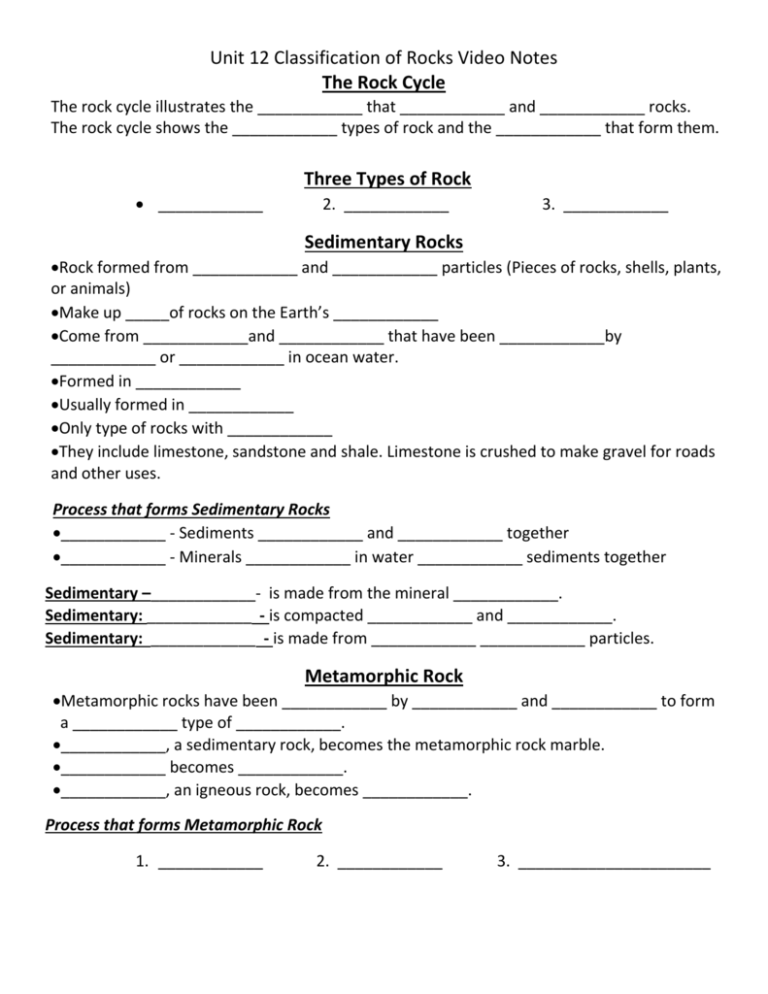Sedimentary Rocks
advertisement

Unit 12 Classification of Rocks Video Notes The Rock Cycle The rock cycle illustrates the ____________ that ____________ and ____________ rocks. The rock cycle shows the ____________ types of rock and the ____________ that form them. Three Types of Rock ____________ 2. ____________ 3. ____________ Sedimentary Rocks Rock formed from ____________ and ____________ particles (Pieces of rocks, shells, plants, or animals) Make up _____of rocks on the Earth’s ____________ Come from ____________and ____________ that have been ____________by ____________ or ____________ in ocean water. Formed in ____________ Usually formed in ____________ Only type of rocks with ____________ They include limestone, sandstone and shale. Limestone is crushed to make gravel for roads and other uses. Process that forms Sedimentary Rocks ____________ - Sediments ____________ and ____________ together ____________ - Minerals ____________ in water ____________ sediments together Sedimentary –____________- is made from the mineral ____________. Sedimentary: ____________ - is compacted ____________ and ____________. Sedimentary: ____________ - is made from ____________ ____________ particles. Metamorphic Rock Metamorphic rocks have been ____________ by ____________ and ____________ to form a ____________ type of ____________. ____________, a sedimentary rock, becomes the metamorphic rock marble. ____________ becomes ____________. ____________, an igneous rock, becomes ____________. Process that forms Metamorphic Rock 1. ____________ 2. ____________ 3. ______________________ Unit 12 Classification of Rocks Video Notes Examples of Metamorphic Rock Arizona ____________ Cobalt blue crystal of ____________ ____________ ____________ is a white rock that was originally limestone. ____________ comes from metamorphosed shale. ____________ is derived from granite. Igneous Rocks Rock formed from the ____________ and ____________ of ____________. Formed from ____________ (magma) The ___________________on Earth were igneous rocks. Process that forms Igneous Rocks ____________ ____________ and ____________ Two Types of Igneous Rocks Intrusive IN-trusive…____________ Formed from ____________ that cooled slowly ____________ the Earth’s surface Have ____________ crystals Extrusive EX-trusive… ____________ Formed from ____________ (lava) that cooled quickly __________________the Earth’s surface Have ____________ crystals Igneous: ____________ - is made mostly of ________________minerals with _______ crystals. Igneous: ____________ - is used in cardiac ____________, as well-crafted obsidian blades have a cutting edge up to ____________sharper than high-quality steel surgical scalpels. It produces a ____________and less tissue trauma, which translates to faster healing and less scar tissue. Igneous: ____________ - is chemically ____________ to ____________ but with ____________ crystals. Igneous: ____________ - is used for ____________ in cemeteries and also household ____________. In other parts of the country, buildings are made from granite. Igneous: ____________ - is a ____________rock made from ____________ lava. Unit 12 Classification of Rocks Video Notes A process whereby compacted sediments bind and stick together and turn into rock A process whereby sediments pack, crush, and settle under the action of gravity and pressure from overlying layers Geometric shape of a mineral that reflects its internal crystalline arrangement of atoms A measure of scratch resistance of various minerals through the ability of a harder minerals to scratch a softer minerals for identification; a set of ten minerals used as a standard of hardness against which an unknown mineral's hardness is compared (Known as Moh’s Hardness Scale) Rock formed when heated magma or lava cools and hardens A result of molten rock material pushed to Earth's surface by volcanic action The way the surface of a mineral reflects light; either metallic or non-metallic such as silky, dull, glassy, or resinous Melted rock material beneath Earth's surface Rock deep within Earth's crust that has been exposed to extreme heat and pressure causing changes to its appearance, structure, and composition A naturally formed, inorganic solid that has a specific chemical formula and repeating three-dimensional structure Rock formed when sediments deposited in layers, compact and cement together under pressure, over long periods of time








